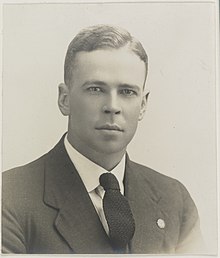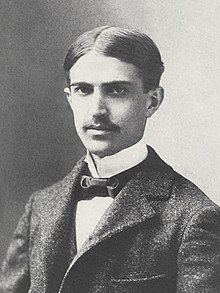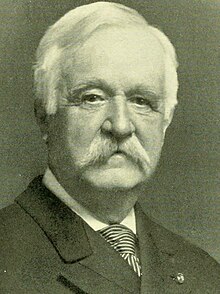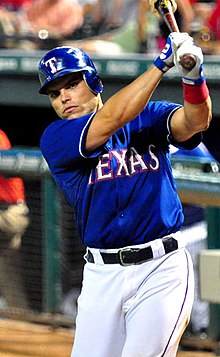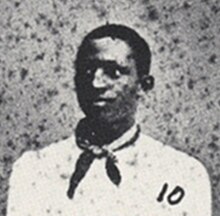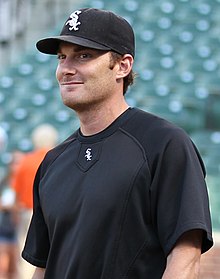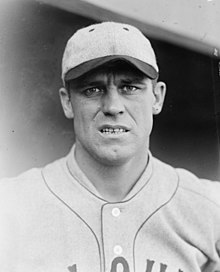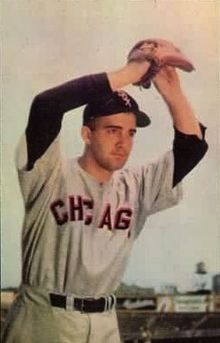Portal:Baseball
Portal maintenance status: (June 2018)
|
| Main page | Content, Categories & Topics | WikiProjects & Things you can do |
The Baseball Portal
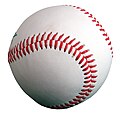
Baseball is a bat-and-ball sport played between two teams of nine players each, taking turns batting and fielding. The game occurs over the course of several plays, with each play generally beginning when a player on the fielding team, called the pitcher, throws a ball that a player on the batting team, called the batter, tries to hit with a bat. The objective of the offensive team (batting team) is to hit the ball into the field of play, away from the other team's players, allowing its players to run the bases, having them advance counter-clockwise around four bases to score what are called "runs". The objective of the defensive team (referred to as the fielding team) is to prevent batters from becoming runners, and to prevent runners' advance around the bases. A run is scored when a runner legally advances around the bases in order and touches home plate (the place where the player started as a batter).
The opposing teams switch back and forth between batting and fielding; the batting team's turn to bat is over once the fielding team records three outs. One turn batting for each team constitutes an inning. A game is usually composed of nine innings, and the team with the greater number of runs at the end of the game wins. Most games end after the ninth inning, but if scores are tied at that point, extra innings are usually played. Baseball has no game clock, though some competitions feature pace-of-play regulations such as the pitch clock to shorten game time.
Baseball evolved from older bat-and-ball games already being played in England by the mid-18th century. This game was brought by immigrants to North America, where the modern version developed. Baseball's American origins, as well as its reputation as a source of escapism during troubled points in American history such as the American Civil War and the Great Depression, have led the sport to receive the moniker of "America's Pastime"; since the late 19th century, it has been unofficially recognized as the national sport of the United States, though in modern times is considered less popular than other sports, such as American football. In addition to North America, baseball spread throughout the rest of the Americas and the Asia–Pacific in the 19th and 20th centuries, and is now considered the most popular sport in parts of Central and South America, the Caribbean, and East Asia, particularly in Japan, South Korea, and Taiwan. (Full article...)
 Featured articles - load new batch
Featured articles - load new batch
-
Image 1
Harmon Clayton Killebrew Jr. (/ˈkɪlɪbruː/; June 29, 1936 – May 17, 2011), nicknamed "the Killer" and "Hammerin' Harmon", was an American professional baseball first baseman, third baseman, and left fielder. He spent most of his 22-year career in Major League Baseball (MLB) with the Minnesota Twins. A prolific power hitter, Killebrew had the fifth-most home runs in major league history at the time of his retirement. He was second only to Babe Ruth in American League (AL) home runs, and was the AL career leader in home runs by a right-handed batter. Killebrew was inducted into the National Baseball Hall of Fame in 1984.
Killebrew was 5-foot-11-inch (180 cm) tall and 213 pounds (97 kg). His compact swing generated tremendous power and made him one of the most feared power hitters of the 1960s, when he hit at least 40 home runs per season eight times. In total Killebrew led the league six times in home runs and three times in RBIs, and was named to 13 All-Star teams. In 1965, he played in the World Series with the Twins, who lost to the Los Angeles Dodgers. His finest season was 1969, when he hit 49 home runs, recorded 140 RBIs and won the AL Most Valuable Player Award while helping lead the Twins to the AL West pennant. (Full article...) -
Image 2
William Harold Ponsford MBE (19 October 1900 – 6 April 1991) was an Australian cricketer. Usually playing as an opening batsman, he formed a successful and long-lived partnership opening the batting for Victoria and Australia with Bill Woodfull, his friend and state and national captain. Ponsford is the only player to twice break the world record for the highest individual score in first-class cricket; Ponsford and Brian Lara are the only cricketers to twice score 400 runs in an innings. Ponsford holds the Australian record for a partnership in Test cricket, set in 1934 in combination with Don Bradman (451 for 2nd wicket)—the man who broke many of Ponsford's other individual records. In fact, he along with Bradman set the record for the highest partnership ever for any wicket in Test cricket history when playing on away soil (451 runs for the second wicket)
Despite being heavily built, Ponsford was quick on his feet and renowned as one of the finest ever players of spin bowling. His bat, much heavier than the norm and nicknamed "Big Bertha", allowed him to drive powerfully and he possessed a strong cut shot. However, critics questioned his ability against fast bowling, and the hostile short-pitched English bowling in the Bodyline series of 1932–33 was a contributing factor in his early retirement from cricket a year and a half later. Ponsford also represented his state and country in baseball, and credited the sport with improving his cricketing skills. (Full article...) -
Image 3
Daniel Lucius "Doc" Adams (November 1, 1814 – January 3, 1899) was an American baseball player and executive who is regarded by historians as an important figure in the sport's early years. For most of his career he was a member of the New York Knickerbockers. He first played for the New York Base Ball Club in 1840 and started his Knickerbockers career five years later, continuing to play for the club into his forties and to take part in inter-squad practice games and matches against opposing teams. Researchers have called Adams the creator of the shortstop position, which he used to field short throws from outfielders. In addition to his playing career, Adams manufactured baseballs and oversaw bat production; he also occasionally acted as an umpire.
From 1847 to 1861, the Knickerbockers selected Adams as their president six times, and as a vice president, treasurer, or director in six other years. As president of the club, Adams was an advocate of rule changes in baseball that resulted in nine-man teams and nine-inning games. When the National Association of Base Ball Players (NABBP) was formed in 1858, he led the rules and regulations committee of the new organization. In his role, Adams ruled that the fields' bases should be 90 feet (27 m) apart, the modern distance, and supported the elimination of the "bound rule", which allowed for balls caught after one bounce to be recorded as outs. He resigned from his positions with the Knickerbockers and NABBP in 1862. Adams' contributions in creating baseball's rules went largely unrecognized for decades after his 1899 death, but in 1980 a letter about him appeared in The New York Times; by 1993, researcher John Thorn had written about Adams' role. Other historians have given him credit for helping to develop the sport, and Thorn has called Adams "first among the Fathers of Baseball". (Full article...) -
Image 4
Stephen Crane (November 1, 1871 – June 5, 1900) was an American poet, novelist, and short story writer. Prolific throughout his short life, he wrote notable works in the Realist tradition as well as early examples of American Naturalism and Impressionism. He is recognized by modern critics as one of the most innovative writers of his generation.
The ninth surviving child of Methodist parents, Crane began writing at the age of four and had several articles published by 16. Having little interest in university studies though he was active in a fraternity, he left Syracuse University in 1891 to work as a reporter and writer. Crane's first novel was the 1893 Bowery tale Maggie: A Girl of the Streets, generally considered by critics to be the first work of American literary Naturalism. He won international acclaim for his Civil War novel The Red Badge of Courage (1895), considered a masterpiece by different critics and writers. (Full article...) -
Image 5

WSNS-TV (channel 44) is a television station in Chicago, Illinois, United States, serving as the local outlet for the Spanish-language network Telemundo. It is owned and operated by NBCUniversal's Telemundo Station Group alongside NBC outlet WMAQ-TV (channel 5). The two stations share studios at the NBC Tower on North Columbus Drive in the city's Streeterville neighborhood and broadcast from the same transmitter atop the Willis Tower in the Chicago Loop.
WSNS-TV began broadcasting in 1970. Originally specializing in the automated display of news headlines, it evolved into Chicago's third full-fledged independent station, carrying movies, local sports, and other specialty programming. This continued until 1980, when WSNS became the Chicago-area station for ON TV, an over-the-air subscription television (STV) service owned by Oak Industries, which took a minority ownership stake in the station. While ON TV was successful in Chicago and the subscription system became the second-largest in the country by total subscribers, the rise of cable television precipitated the end of the business in 1985, with WSNS-TV as the last ON TV station standing. (Full article...) -
Image 6
George Herman "Babe" Ruth (February 6, 1895 – August 16, 1948) was an American professional baseball player whose career in Major League Baseball (MLB) spanned 22 seasons, from 1914 through 1935. Nicknamed "the Bambino" and "the Sultan of Swat", he began his MLB career as a star left-handed pitcher for the Boston Red Sox, but achieved his greatest fame as a slugging outfielder for the New York Yankees. Ruth is regarded as one of the greatest sports heroes in American culture and is considered by many to be the greatest baseball player of all time. In 1936, Ruth was elected to the Baseball Hall of Fame as one of its "first five" inaugural members.
At age seven, Ruth was sent to St. Mary's Industrial School for Boys, a reformatory where he was mentored by Brother Matthias Boutlier of the Xaverian Brothers, the school's disciplinarian and a capable baseball player. In 1914, Ruth was signed to play Minor League baseball for the Baltimore Orioles but was soon sold to the Red Sox. By 1916, he had built a reputation as an outstanding pitcher who sometimes hit long home runs, a feat unusual for any player in the dead-ball era. Although Ruth twice won 23 games in a season as a pitcher and was a member of three World Series championship teams with the Red Sox, he wanted to play every day and was allowed to convert to an outfielder. With regular playing time, he broke the MLB single-season home run record in 1919 with 29. (Full article...) -
Image 7
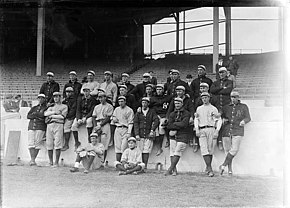
The 1913 squad, the first that went by the name "Yankees"
The history of the New York Yankees Major League Baseball (MLB) team spans more than a century. Frank J. Farrell and William Stephen Devery bought the rights to an American League (AL) club in New York City after the 1902 season. The team, which became known as the Yankees in 1913, rarely contended for the AL championship before the acquisition of outfielder Babe Ruth after the 1919 season. With Ruth in the lineup, the Yankees won their first AL title in 1921, followed by their first World Series championship in 1923. Ruth and first baseman Lou Gehrig were part of the team's Murderers' Row lineup, which led the Yankees to a then-AL record 110 wins and a Series championship in 1927 under Miller Huggins. They repeated as World Series winners in 1928, and their next title came under manager Joe McCarthy in 1932.
The Yankees won the World Series every year from 1936 to 1939 with a team that featured Gehrig and outfielder Joe DiMaggio, who recorded a record hitting streak during New York's 1941 championship season. New York set a major league record by winning five consecutive championships from 1949 to 1953, and appeared in the World Series nine times from 1955 to 1964. Mickey Mantle, Yogi Berra, and Whitey Ford were among the players fielded by the Yankees during the era. After the 1964 season, a lack of effective replacements for aging players caused the franchise to decline on the field, and the team became a money-loser for owners CBS while playing in an aging stadium. (Full article...) -
Image 8Los Angeles Angels center fielder Mike Trout hits a home run on a pitch from New York Mets pitcher Tommy Milone on May 21, 2017.
Baseball is a bat-and-ball sport played between two teams of nine players each, taking turns batting and fielding. The game occurs over the course of several plays, with each play generally beginning when a player on the fielding team, called the pitcher, throws a ball that a player on the batting team, called the batter, tries to hit with a bat. The objective of the offensive team (batting team) is to hit the ball into the field of play, away from the other team's players, allowing its players to run the bases, having them advance counter-clockwise around four bases to score what are called "runs". The objective of the defensive team (referred to as the fielding team) is to prevent batters from becoming runners, and to prevent runners' advance around the bases. A run is scored when a runner legally advances around the bases in order and touches home plate (the place where the player started as a batter).
The initial objective of the batting team is to have a player reach first base safely; this generally occurs either when the batter hits the ball and reaches first base before an opponent retrieves the ball and touches the base, or when the pitcher persists in throwing the ball out of the batter's reach. Players on the batting team who reach first base without being called "out" can attempt to advance to subsequent bases as a runner, either immediately or during teammates' turns batting. The fielding team tries to prevent runs by using the ball to get batters or runners "out", which forces them out of the field of play. The pitcher can get the batter out by throwing three pitches which result in strikes, while fielders can get the batter out by catching a batted ball before it touches the ground, and can get a runner out by tagging them with the ball while the runner is not touching a base. (Full article...) -
Image 9Rogers Hornsby tags out Babe Ruth who is caught attempting to steal second base, ending the 1926 World Series.
The 1926 World Series was the championship series of the 1926 Major League Baseball season. The 23rd edition of the Series, it pitted the National League champion St. Louis Cardinals against the American League champion New York Yankees. The Cardinals defeated the Yankees four games to three in the best-of-seven series, which took place from October 2 to 10, 1926, at Yankee Stadium and Sportsman's Park.
This was the first World Series appearance (and first National League pennant win) for the Cardinals, and would be the first of 11 World Series championships in Cardinals history. The Yankees were playing in their fourth World Series in six years after winning their first American League pennant in 1921 and their first world championship in 1923. They would play in another 36 World Series (and win 26 of those), as of the end of the 2023 season. (Full article...) -
Image 10
Morgan Gardner Bulkeley (December 26, 1837 – November 6, 1922) was an American politician of the Republican Party, businessman, and insurance executive. In 1876, he served as the first president of baseball's National League and, because of that, was inducted into the National Baseball Hall of Fame in 1937, a choice that remains controversial, since his time as a baseball executive was short.
Bulkeley was born in East Haddam, Connecticut. His father was Judge Eliphalet Adams Bulkeley, a prominent local lawyer and businessman, who became the first president of the Aetna Life Insurance Company. The family moved to Hartford, where Morgan Bulkeley was educated, before he took a job in the city of Brooklyn, New York. He served briefly in the American Civil War, where he saw no combat. When his father died in 1872, he moved back to Hartford and became a bank president and a board member of Aetna, becoming its president in 1879, a post he held the rest of his life. (Full article...) -
Image 11
Osborne Earl Smith (born December 26, 1954) is an American former professional baseball player. Nicknamed "The Wizard of Oz", Smith played shortstop for the San Diego Padres and St. Louis Cardinals in Major League Baseball, winning the National League Gold Glove Award for defensive play at shortstop for 13 consecutive seasons. A 15-time All-Star, Smith accumulated 2,460 hits and 580 stolen bases during his career, and won the National League Silver Slugger Award as the best hitter at shortstop in 1987. He was elected to the Baseball Hall of Fame in his first year of eligibility in 2002. He was also elected to the St. Louis Cardinals Hall of Fame in the inaugural class of 2014.
Smith was born in Mobile, Alabama; his family moved to Watts, Los Angeles, when he was six years old. While participating in childhood athletic activities, Smith possessed quick reflexes; he went on to play baseball at Locke High School in Los Angeles, then at California Polytechnic State University, San Luis Obispo. Drafted as an amateur player by the Padres, Smith made his major league debut in 1978. He quickly established himself as an outstanding fielder, and later became known for performing backflips on special occasions while taking his position at the beginning of a game. Smith won his first Gold Glove Award in 1980 and made his first All-Star Game appearance in 1981. (Full article...) -
Image 12

On July 10, 1932, the Philadelphia Athletics beat the Cleveland Indians 18–17 in 18 innings in a Major League Baseball game played at League Park in Cleveland. Several major-league records were set during the game; for example, Johnny Burnett of the Indians became the only player to hit safely nine (or even eight) times in a game, while Cleveland's 33 hits and the teams' combined 58 hits are also single-game records. Pitcher Eddie Rommel secured the win for the Athletics, pitching an American League-record 17 innings in relief after Philadelphia's Lew Krausse gave up three runs in the first inning. The 29 hits Rommel allowed are a major-league record; the 14 runs against him are the most given up by a winning pitcher.
Coming into the game, the Athletics, who were the three-time defending American League champions, trailed the New York Yankees in the standings by 71⁄2 games. Sunday baseball was still illegal in Philadelphia, forcing the Athletics to make one-game road trips on some Sundays, including July 10. With his pitching staff exhausted by six games in the previous three days, the owner and manager of the Athletics, Connie Mack, took only two pitchers on the train trip to Cleveland, giving the rest of the staff the day off. With no chance of being relieved except by a position player, Rommel pitched with mixed effectiveness, giving up six runs in the seventh inning but only two runs in the final nine innings of the game. He aided his own cause by getting three hits in seven at bats. Cleveland's Wes Ferrell took the loss after Jimmie Foxx got his sixth hit of the game and then scored. Foxx had already batted in eight runs, having hit three home runs and accumulated sixteen total bases, tying a record that has since been broken. (Full article...) -
Image 13

Ian Michael Chappell (born 26 September 1943) is a former cricketer who played for South Australia and Australia. Known as "Chappelli", he is considered as one of the greatest captains the game has seen. He captained Australia between 1971 and 1975 before taking a central role in the breakaway World Series Cricket organisation. Born into a cricketing family—his grandfather and brother also captained Australia—Chappell made a hesitant start to international cricket playing as a right-hand middle-order batsman and spin bowler. He found his niche when promoted to bat at number three. Chappell's blunt verbal manner led to a series of confrontations with opposition players and cricket administrators; the issue of sledging first arose during his tenure as captain, and he was a driving force behind the professionalisation of Australian cricket in the 1970s. He was the captain of the Australian squad which finished as runners-up at the 1975 Cricket World Cup.
John Arlott called him "a cricketer of effect rather than the graces". An animated presence at the batting crease, he constantly adjusted his equipment and clothing, and restlessly tapped his bat on the ground as the bowler ran in. Basing his game on a sound defence learned during many hours of childhood lessons, Chappell employed the drive and square cut to full effect. He had an idiosyncratic method of playing back and across to a ball of full length and driving wide of mid-on, but his trademark shot was the hook, saying "three bouncers an over should be worth 12 runs to me". A specialist slip fielder, he was the fourth player to take one hundred Test catches. (Full article...) -
Image 14
Stanley Frank Musial (/ˈmjuːziəl, -ʒəl/; born Stanislaw Franciszek Musial; November 21, 1920 – January 19, 2013), nicknamed "Stan the Man", was an American baseball outfielder and first baseman. Widely considered to be one of the greatest and most consistent hitters in baseball history, Musial spent 22 seasons in Major League Baseball (MLB), playing for the St. Louis Cardinals, from 1941 to 1944 and from 1946 to 1963, before becoming a first-ballot inductee into the Baseball Hall of Fame in 1969.
Musial was born in Donora, Pennsylvania, where he frequently played baseball informally or in organized settings, and eventually played on the baseball team at Donora High School. Signed to a professional contract by the St. Louis Cardinals as a pitcher in 1938, Musial was converted into an outfielder and made his major league debut in 1941. Noted for his unique batting stance, he quickly established himself as a consistent and productive hitter. In his first full season, 1942, the Cardinals won the World Series. The following year, he led the NL in six different offensive categories and earned his first MVP award. He was also named to the NL All-Star squad for the first time; he appeared in every All-Star game in every subsequent season he played. Musial won his second World Series championship in 1944, then missed the 1945 season while serving in the Navy. After completing his military service, Musial returned to baseball in 1946 and resumed his consistent hitting. That year he earned his second MVP award and third World Series title. His third MVP award came in 1948, when he finished one home run short of winning baseball's Triple Crown. After struggling offensively in 1959, Musial used a personal trainer to help maintain his productivity until he decided to retire in 1963. (Full article...) -
Image 15
Michael Jeffrey Jordan (born February 17, 1963), also known by his initials MJ, is an American businessman and former professional basketball player. He played 15 seasons in the National Basketball Association (NBA) between 1984 and 2003, winning six NBA championships with the Chicago Bulls. He was integral in popularizing basketball and the NBA around the world in the 1980s and 1990s, becoming a global cultural icon. His profile on the NBA website states, "By acclamation, Michael Jordan is the greatest basketball player of all time."
Jordan played college basketball with the North Carolina Tar Heels. As a freshman, he was a member of the Tar Heels' national championship team in 1982. Jordan joined the Bulls in 1984 as the third overall draft pick and quickly emerged as a league star, entertaining crowds with his prolific scoring while gaining a reputation as one of the best defensive players. His leaping ability, demonstrated by performing slam dunks from the free-throw line in Slam Dunk Contests, earned him the nicknames "Air Jordan" and "His Airness". Jordan won his first NBA title with the Bulls in 1991 and followed that achievement with titles in 1992 and 1993, securing a three-peat. Citing "physical and mental exhaustion" from basketball and superstardom, Jordan abruptly retired from basketball before the 1993–94 NBA season to play Minor League Baseball in the Chicago White Sox organization. He returned to the Bulls in March 1995 and led them to three more championships in 1996, 1997, and 1998, as well as a then-record 72 regular season wins in the 1995–96 NBA season. Jordan retired for the second time in January 1999, returning for two more NBA seasons from 2001 to 2003 as a member of the Washington Wizards. He was selected to play for the United States national team during his college and NBA careers, winning four gold medals—at the 1983 Pan American Games, 1984 Summer Olympics, 1992 Tournament of the Americas and 1992 Summer Olympics—while also being undefeated. (Full article...)
General images - load new batch
-
Image 2The NL champion New York Giants baseball team, 1913. Fred Merkle, sixth in line, had committed a baserunning gaffe in a crucial 1908 game that became famous as Merkle's Boner. (from History of baseball)
-
Image 3In May 2010, the Philadelphia Phillies' Roy Halladay pitched the 20th major league perfect game. That October, he pitched only the second no-hitter in MLB postseason history. (from History of baseball)
-
Image 6Sadaharu Oh managing the Japan national team in the 2006 World Baseball Classic. Playing for the Central League's Yomiuri Giants (1959–80), Oh set the professional world record for home runs with 868. (from History of baseball)
-
Image 7A New York Yankees batter (Andruw Jones) and a Boston Red Sox catcher at Fenway Park (from Baseball)
-
Image 8A game from the Cantigas de Santa Maria, c. 1280, involving tossing a ball, hitting it with a stick and competing with others to catch it (from History of baseball)
-
Image 9The standard fielding positions (from Baseball rules)
-
Image 10Fenway Park, home of the Boston Red Sox. The Green Monster is visible beyond the playing field on the left. (from Baseball)
-
Image 12The American Tobacco Company's line of baseball cards featured shortstop Honus Wagner of the Pittsburgh Pirates from 1909 to 1911. In 2007, the card shown here sold for $2.8 million. (from Baseball)
-
Image 13Sadaharu Oh managing the Japan national team in the 2006 World Baseball Classic. Playing for the Central League's Yomiuri Giants (1959–80), Oh set the professional world record for home runs. (from Baseball)
-
Image 15Pitchers are generally substituted during mound visits (team gatherings at the pitcher's mound). (from Baseball rules)
-
Image 17The strike zone determines the result of most pitches, and varies in vertical length for each batter. (from Baseball)
-
Image 19Japanese-Americans spectating a World War II-era game while in an internment camp. America's ties to immigrants and to Japan have been deeply shaped by a shared baseball heritage. (from History of baseball)
-
Image 20Baserunners generally stand a short distance away from their base between pitches, preparing themselves to either go back or steal the next base. (from Baseball rules)
-
Image 21Alexander Cartwright, father of modern baseball (from History of baseball)
-
Image 22Defensive positions on a baseball field, with abbreviations and scorekeeper's position numbers (not uniform numbers) (from Baseball)
-
Image 23Diagram of a baseball field Diamond may refer to the square area defined by the four bases or to the entire playing field. The dimensions given are for professional and professional-style games. Children often play on smaller fields. (from Baseball)
-
Image 24A well-worn baseball (from Baseball)
-
Image 25A pitcher handing off the ball after being taken out of the game during a mound meeting. (from Baseball)
-
Image 26Pick-off attempt on runner (in red) at first base (from Baseball rules)
-
Image 28By the 1860s Civil War, baseball (bottom) had overtaken its fellow bat-and-ball sport cricket (top) in popularity within the United States. (from History of baseball)
-
Image 29Cy Young—the holder of many major league career marks, including wins and innings pitched, as well as losses—in 1908. MLB's annual awards for the best pitcher in each league are named for Young. (from Baseball)
-
Image 30Jackie Robinson in 1945, with the era's Kansas City Royals, a barnstorming squad associated with the Negro American League's Kansas City Monarchs (from Baseball)
-
Image 311906 World Series, infielders playing "in" for the expected bunt and the possible play at the plate with the bases loaded (from Baseball rules)
-
Image 32A runner sliding into home plate and scoring. (from Baseball)
-
Image 33A batter follows through after swinging at a pitched ball. (from Baseball rules)
-
Image 34Baseball games sometimes end in a walk-off home run, with the batting team usually gathering at home plate to celebrate the scoring of the winning run(s). (from Baseball rules)
-
Image 35The typical motion of a right-handed pitcher (from Baseball rules)
-
Image 36Pesäpallo, a Finnish variation of baseball, was invented by Lauri "Tahko" Pihkala in the 1920s, and after that, it has changed with the times and grown in popularity. Picture of Pesäpallo match in 1958 in Jyväskylä, Finland. (from Baseball)
-
Image 37Jackie Robinson in 1945, with the era's Kansas City Royals, a barnstorming squad associated with the Negro American League's Kansas City Monarchs (from History of baseball)
-
Image 38Cover of Official Base Ball Rules, 1921 edition, used by the American League and National League (from Baseball rules)
-
Image 39An Afghan girl playing baseball in August 2002 (from Baseball)
-
Image 412013 World Baseball Classic championship match between the Dominican Republic and Puerto Rico, March 20, 2013 (from Baseball)
-
Image 42Rickey Henderson—the major leagues' all-time leader in runs and stolen bases—stealing third base in a 1988 game (from Baseball)
-
Image 44A first baseman receives a pickoff throw, as the runner dives back to first base. (from Baseball)
-
Image 45The strike zone, which determines the outcome of most pitches, varies in vertical length depending on the batter's typical height while swinging. (from Baseball rules)
 Good articles - load new batch
Good articles - load new batch
-
Image 1
Iván Rodríguez Torres (born November 27, 1971), nicknamed "Pudge" and "I-Rod", is a Puerto Rican former Major League Baseball catcher. A member of the National Baseball Hall of Fame and Museum, Rodríguez is widely regarded as one of the greatest catchers in MLB history. He played for the Texas Rangers (in two separate stints, comprising the majority of his career), Florida Marlins, Detroit Tigers, New York Yankees, Houston Astros and Washington Nationals.
Rodríguez was awarded the AL MVP award in 1999. He won the 2003 World Series with the Florida Marlins and played in the 2006 World Series while with the Tigers. In 2009, he set an MLB record by catching his 2,227th game, passing Carlton Fisk. He had the best career caught-stealing percentage of any major league catcher, at 45.68% (versus a league average of 31%), and he had nine seasons with a caught-stealing rate of 50% or higher. Only one major league catcher (Yadier Molina) has more putouts. (Full article...) -
Image 2

WTXF-TV (channel 29) is a television station in Philadelphia, Pennsylvania, United States, serving as the market's Fox network outlet. Owned and operated by the Fox Television Stations division, the station maintains studios on Market Street in Center City and a primary transmitter on the Roxborough tower farm, with a secondary transmitter on South Mountain in Allentown.
Channel 29 is the longest continuously operated Philadelphia UHF station, since May 16, 1965, as WIBF-TV from studios in the suburb of Jenkintown. WIBF-TV was owned by the Fox family alongside WIBF-FM 103.9. It was the first of three new commercial UHF outlets that year, broadcasting as an independent station focusing on community and sports programming. Taft Broadcasting purchased channel 29 in 1969 and renamed it WTAF-TV. Under Taft, the station slowly emerged as the leading independent station in the Philadelphia market with popular sports coverage, movies, and syndicated programs. The station was the broadcast outlet for the Philadelphia Flyers hockey team between 1971 and 1985 and for the Philadelphia Phillies baseball team from 1983 to 1992. The latter deal came after Taft Broadcasting purchased 47 percent of the team. In early 1986, WTAF-TV began producing a 10 p.m. local newscast. Later that year, it became affiliated with the new Fox television network. (Full article...) -
Image 3
Weldy Wilberforce Walker (July 27, 1860 – November 23, 1937), sometimes known as Welday Walker and W. W. Walker, was an American baseball player. In 1884, he became the third African American to play Major League Baseball.
Walker played at Oberlin College and the University of Michigan. In July 1884, he joined the Toledo Blue Stockings of the American Association which was then part of Major League Baseball. His brother Moses Fleetwood Walker, commonly known as Fleetwood (or "Fleet") Walker, was the second African American to play Major League Baseball, making his debut two months before Weldy. In 1887, as racial segregation took hold in professional baseball, Weldy joined the Pittsburgh Keystones of the short-lived National Colored Base Ball League. (Full article...) -
Image 4Pederson with the Los Angeles Dodgers in 2017
Joc Russell Pederson (/ˈpiːdərsən/ PEE-dər-sən; born April 21, 1992) is an American professional baseball outfielder who is a free agent. He has played in Major League Baseball (MLB) for the Los Angeles Dodgers, Chicago Cubs, Atlanta Braves, San Francisco Giants, and Arizona Diamondbacks. He is a two-time World Series champion and a two-time All-Star. Internationally, Pederson represents the Israel national baseball team in international competition.
The son of former MLB player Stu Pederson, Joc was drafted by the Dodgers in the 11th round of the 2010 MLB draft out of Palo Alto High School. By virtue of his Jewish heritage, he played for the Israel national baseball team in the 2013 World Baseball Classic. He was ranked the Dodgers' top prospect by Baseball America after the 2013 season. In 2014, he was named the Pacific Coast League (PCL) Most Valuable Player after hitting 30 home runs and stealing 30 bases, and he made his major league debut that September. (Full article...) -
Image 5
The Philadelphia Phillies' 2009 season was the 127th season in the history of the franchise. The team, managed by Charlie Manuel, began their sixth season at Citizens Bank Park and defense of their 2008 World Series championship on April 5. After collecting a third straight National League East championship, the Phillies won their second consecutive National League pennant for the first time in franchise history; however they were defeated by the New York Yankees in the World Series.
The Phillies posted a second consecutive winning April to open the season with an 11–9 record, but the month was marred by the death of legendary broadcaster Harry Kalas. After opening the month of May against the rival New York Mets, the Phillies met President Barack Obama to celebrate their World Series victory the previous season, and had two rookie pitchers win consecutive starts for the first time since 2007. Starting pitcher Jamie Moyer earned his 250th career win during the month, while first baseman Ryan Howard and outfielder Raúl Ibañez became the first Phillies teammates to hit 10 home runs in the same month. Echoing their strong run in the middle of the 2008 season, the Phillies compiled a 16–4 record in late May and early June, which was countered by weakness during interleague play in late June. (Full article...) -
Image 6
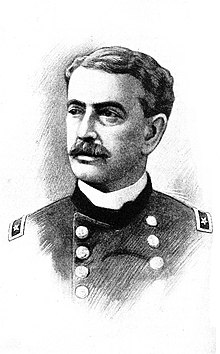
Abner Doubleday
The Doubleday myth is the claim that the sport of baseball was invented in 1839 by the future American Civil War general Abner Doubleday in Cooperstown, New York. In response to a dispute over whether baseball originated in the United States or was a variation of the British game rounders, the Mills Commission was formed in 1905 to seek out evidence. Mining engineer Abner Graves authored a letter claiming that Doubleday invented baseball. The letter was published in a newspaper and eventually used by the Mills Commission to support its finding that the game was of American origin. In 1908, it named Doubleday the creator of baseball.
The claim initially received a favorable reception from Americans, but eventually garnered criticism from various writers. Modern baseball historians generally consider the myth to be false. Graves' testimony has been critiqued in various regards, as the details of his story and his reliability as a witness have been questioned, and the Mills Commission made departures from his letter in its report. The National Baseball Hall of Fame and Museum was built in the town where Graves said the game was created, Cooperstown. The legend is well known among fans of the sport. (Full article...) -
Image 7
Clifford Michael Brumbaugh (born April 21, 1974) is an American former professional baseball player. From Wilmington, Delaware, he played college baseball for the Delaware Fightin' Blue Hens where he was a two-time All-American and the North Atlantic Conference (NAC) Player of the Year. Drafted by the Texas Rangers of Major League Baseball (MLB) in 1995, he played in the minor leagues until being called up to the majors in 2001.
After playing seven games for the Rangers, Brumbaugh was waived and claimed by the Colorado Rockies, playing 14 games with the Rockies that season. After spending 2002 and part of 2003 in the minor leagues, he requested a release and joined the Hyundai Unicorns of the KBO League mid-season. He became a top player for the Unicorns and helped them win consecutive Korean Series titles, while Brumbaugh won the Golden Glove Award and was league batting champion in 2004. (Full article...) -
Image 8Davis with the Baltimore Orioles in 2018
Christopher Lyn Davis (born March 17, 1986), nicknamed "Crush Davis", is an American former professional baseball first baseman. He played in Major League Baseball (MLB) for the Texas Rangers and Baltimore Orioles. He batted left-handed and threw right-handed. While primarily a first baseman throughout his career, Davis also spent time at designated hitter, third baseman, and outfielder.
Davis attended Navarro Junior College and was selected by the Rangers in the fifth round of the 2006 MLB draft. He ascended quickly through the Rangers' minor league system, getting named their Minor League Player of the Year in 2007. He was called up in the middle of 2008 and had a strong start to his major league career. He was the Rangers' starting first baseman for 92 games in 2009 and hit 21 home runs, but a low batting average and his tendency to strike out left the Rangers dissatisfied with him. Because of this, the Rangers sent Davis back and forth between the minors and the majors over the next two years and left him off their playoff roster in 2010. On July 30, 2011, they traded him to the Orioles. (Full article...) -
Image 9
Philip Humber of the Chicago White Sox pitched a perfect game against the Seattle Mariners by retiring all 27 batters he faced on April 21, 2012, as the White Sox defeated the Mariners 4–0. It was the 21st perfect game in Major League Baseball (MLB) history and the third by a member of the White Sox, and remains the earliest calendar date for a perfect game in MLB history. It was Humber's first career complete game, although he had come close to achieving no-hitters on several occasions at several levels of organized baseball. The game was played in Seattle and broadcast regionally by Fox Sports in the two teams' metropolitan areas.
Humber, a top pitching prospect from a Texas high school, attended Rice University, where he had a successful career. A high draft pick by the New York Mets, he debuted in MLB for the Mets before headlining a group of four prospects traded to the Minnesota Twins for Johan Santana. After two ineffective seasons with the Twins, Humber pitched a season for the Kansas City Royals. Acquired on waivers by the Chicago White Sox in 2011, Humber had his first successful season in an MLB starting rotation. The perfect game, Humber's 30th career start and his 2nd of the 2012 season, totaled 96 pitches. (Full article...) -
Image 10"A Hero Sits Next Door" is the fifth episode in the first season of the American animated television series Family Guy. It originally aired on the Fox network in the United States on May 2, 1999. The episode features the introduction of Joe Swanson, who would become a main character in the series. Peter Griffin must find a replacement player for an upcoming softball game. Peter eventually convinces Joe to play for the team after learning that he played baseball in college. When Joe shows up the following morning, Peter realizes that Joe is in a wheelchair. Joe turns out to be a great player, and the team wins the game. Peter becomes jealous of Joe and tries to become a hero. In a subplot, Meg Griffin tries to get Joe's son Kevin to notice her.
"A Hero Sits Next Door" was directed by Monte Young and written by the writing team of Mike Barker and Matt Weitzman. It featured guest performances by actress Suzie Plakson, figure skater Michelle Kwan, as well as actors Wally Wingert and Carlos Alazraqui. Much of the episode features a cutaway style of humor that is typically used in Family Guy, many of which feature cultural references and include Super Friends, Pez, Teletubbies, and the assassinations of John F. Kennedy and Robert F. Kennedy. (Full article...) -
Image 11
George Harold Sisler (March 24, 1893 – March 26, 1973), nicknamed "Gorgeous George", was an American professional baseball first baseman and player-manager. From 1915 through 1930, he played in Major League Baseball (MLB) for the St. Louis Browns, Washington Senators, and Boston Braves. He managed the Browns from 1924 through 1926.
Sisler played college baseball for the University of Michigan and was signed by the St. Louis Browns in 1915. He won the American League (AL) batting title in 1920 and 1922. In 1920, he batted .407 and recorded 257 hits, the record until Ichiro Suzuki had 262 in 2004. Sisler won the AL Most Valuable Player Award in 1922, finishing with a batting average of .420, the third-highest batting average by AL or NL players after 1900. An attack of sinusitis caused vision troubles that jeopardized Sisler's career, but he returned to playing in 1924, remaining in the major leagues through the 1930 season. After Sisler retired as a player, he worked as a major league scout and aide. (Full article...) -
Image 12
Walter William Pierce (April 2, 1927 – July 31, 2015) was an American starting pitcher in Major League Baseball between 1945 and 1964 who played most of his career for the Chicago White Sox. He was the team's star pitcher in the decade from 1952 to 1961, when they posted the third best record in the major leagues, and received the Sporting News Pitcher of the Year Award for the American League (AL) in 1956 and 1957 after being runner-up in both 1953 and 1955. A seven-time All-Star, he led the American League (AL) in complete games three times despite his slight build, and in wins, earned run average (ERA) and strikeouts once each. He pitched four one-hitters and seven two-hitters in his career, and on June 27, 1958 came within one batter of becoming the first left-hander in 78 years to throw a perfect game.
He was one of the principal figures in Chicago's fierce rivalry with the New York Yankees; particularly notable were his matchups with Whitey Ford, with the two left-handers opposing one another as starters 14 times from 1955 to 1960. Pierce's record suffered from pitching so much against New York – who he faced more often than any other team – when the Yankees dynasty was at its peak; but although his career record against New York was only 25–37, that was still slightly better than the 27–41 mark compiled by National League (NL) championship teams over 11 World Series against the Yankees during the same period. (Full article...) -
Image 13
Ross Middlebrook "Pep" Youngs (April 10, 1897 – October 22, 1927) was an American professional baseball player. Nicknamed "Pep", he played ten seasons in Major League Baseball for the New York Giants from 1917 through 1926, playing right field almost exclusively. Youngs was a part of the Giants teams that won four consecutive National League pennants and the 1921 and 1922 World Series.
From Shiner, Texas, Youngs excelled at baseball and American football at the West Texas Military Institute. After beginning his professional career in minor league baseball, Youngs was signed by the Giants in 1916. Youngs had a lifetime .322 batting average with the Giants and batted over .300 nine times in his career, including eight consecutive seasons. His career was cut short by illness, however, as he died at the age of 30 of Bright's disease. (Full article...) -
Image 14Jews have been involved in baseball since the sport's beginnings in the mid-19th century and have contributed to its evolution in many capacities, including players, agents, team owners, executives, umpires, broadcasters, and fans. In the United States, particularly, baseball played a large part in the assimilation of American Jews into American society at a time of rampant antisemitism and when Jews were immigrating to America to escape persecution. Today, it remains a very important part in Jewish American culture.
On the field, Jewish baseball players faced constant antisemitic heckles from opponents and fans, with many hiding their heritage to avoid discrimination in the league. Despite this, a number of Jewish players overcame such abuse and went on to become stars. Two such players, Hank Greenberg and Sandy Koufax, were both elected to the Baseball Hall of Fame and are widely considered to be amongst the most important and iconic players in baseball history. Similarly, off the field, Jews were involved deeply in the evolution of the game with executive Barney Dreyfuss, a Jewish immigrant who responsible for the founding of the World Series, the most prestigious event in baseball, and Marvin Miller who revolutionized the relationship between players and owners by unionizing players and helping usher in the era of free agency. (Full article...) -
Image 15
Miller James Huggins (March 27, 1878 – September 25, 1929) was an American professional baseball player and manager. Huggins played second base for the Cincinnati Reds (1904–1909) and St. Louis Cardinals (1910–1916). He managed the Cardinals (1913–1917) and New York Yankees (1918–1929), including the Murderers' Row teams of the 1920s that won six American League (AL) pennants and three World Series championships.
Huggins was born in Cincinnati. He received a degree in law from the University of Cincinnati, where he was also captain on the baseball team. Rather than serve as a lawyer, Huggins chose to pursue a professional baseball career. He played semi-professional and minor league baseball from 1898 through 1903, at which time he signed with the Reds. (Full article...)
Did you know (auto-generated) - load new batch

- ... that baseball player Joey Marciano is a cousin of world heavyweight champion Rocky Marciano?
- ... that Helene Hathaway Britton, the first woman to own a Major League Baseball team, was unsuccessfully pressured by other club owners to sell the team?
- ... that Gaylord Perry admitted that he had cheated in baseball in his autobiography Me and the Spitter?
- ... that Cy Block and Ross Horning testified before the United States Congress about how the reserve clause limited their careers in professional baseball?
- ... that in 1915, Walter McCredie unsuccessfully challenged the baseball color line that prohibited non-white players?
- ... that Chuck Eisenmann went from professionally pitching in baseball to owning and training the dogs that starred on the Canadian television series The Littlest Hobo?
- ... that CBS Sports said the Milwaukee Brewers ball-in-glove logo "might just be the best in all of baseball"?
- ... that labor lawyer Dick Moss argued the 1975 case which resulted in the establishment of free agency in Major League Baseball?
Quotes
| You spend a good piece of your life gripping a baseball, and in the end it turns out that it was the other way around all the time. |
 Featured lists - load new batch
Featured lists - load new batch
-
Image 1

Félix Hernández, the 2007 and 2009-2018 Opening Day starter
The Seattle Mariners are a Major League Baseball (MLB) franchise based in Seattle, Washington. They play in the American League West division. The first game of the new baseball season for a team is played on Opening Day, and being named the Opening Day starter is an honor, which is often given to the player who is expected to lead the pitching staff that season, though there are various strategic reasons why a team's best pitcher might not start on Opening Day. The Mariners have used 15 different Opening Day starting pitchers in their 41 seasons. The 15 starters have a combined Opening Day record of 15 wins, 13 losses (15–13) and 13 no decisions. No decisions are only awarded to the starting pitcher if the game is won or lost after the starting pitcher has left the game.
Félix Hernández has the Mariners' record for most Opening Day starts with eleven, recording a record of 7–2. Randy Johnson has the most starts in the former home ballpark of the Mariners, the Kingdome, compiling an Opening Day record of 2–0 in 6 starts. Jamie Moyer has the most starts in Safeco Field, the Mariners' current home ballpark, and has an Opening Day record of 1–2. Mark Langston has the worst winning percentage as the Opening Day starting pitcher with a record of 0–3, all of which were pitched on the road. (Full article...) -
Image 2

Iván Rodríguez has won 13 Gold Gloves, the most among catchers.
The Rawlings Gold Glove Award, usually referred to as the Gold Glove, is the award given annually to the Major League Baseball players judged to have exhibited superior individual fielding performances at each fielding position in both the National League (NL) and the American League (AL), as voted by the managers and coaches in each league. Managers are not permitted to vote for their own players. Eighteen Gold Gloves are awarded each year (with the exception of 1957, 1985, 2007 and 2018), one at each of the nine positions in each league. In 1957, the baseball glove manufacturer Rawlings created the Gold Glove Award to commemorate the best fielding performance at each position. The award was created from a glove made from gold lamé-tanned leather and affixed to a walnut base. Initially, only one Gold Glove per position was awarded to the top fielder at each position in the entire league; however, separate awards were given for the National and American Leagues beginning in 1958.
Iván Rodríguez has won the most Gold Gloves at catcher, with 13; all were won with the Texas Rangers or the Detroit Tigers (both American League teams), though Rodríguez has played in both leagues. Johnny Bench, who spent his entire career with the Cincinnati Reds, leads National Leaguers in wins, and is second overall with 10 Gold Gloves. Yadier Molina is third overall and second in the NL all time with nine. Bob Boone, who is a member of one of four family pairs to win Gold Glove Awards, won seven between both leagues during his career. Jim Sundberg has won six Gold Gloves, with Bill Freehan and Salvador Pérez winning five. There have been four 4-time winners at catcher: Del Crandall, Mike Matheny, Charles Johnson, and Tony Peña. Hall of Famers who have won as catchers include Bench, Rodriguez, Carlton Fisk, and Gary Carter.[d] The other family pair to win Gold Gloves as catchers are brothers Bengie and Yadier Molina, who have won eleven awards between them as of the end of the 2018 season[update]. (Full article...) -
Image 3

Team photograph of the 1888 Kansas City Cowboys
The Kansas City Cowboys were a professional baseball team based in Kansas City, Missouri that played in the American Association for two seasons from 1888 to 1889. The franchise initially used Association Park as their home field in 1888, then moved to Exposition Park for the 1889 season.
The team began the 1888 season with part-time outfielder Dave Rowe as their player-manager. He was released from the team after beginning the season with a win–loss record of 14–36 though 50 games. He was replaced with second baseman Sam Barkley, who did not improve the team's play, winning 22 of the next 58 games. He was replaced with non-playing manager Bill Watkins, who finished the season. Although the Cowboys completed their initial season in last place out of the league's eight teams, there were notable player achievements; on June 6, Henry Porter threw a no-hitter, and on June 13, Barkley hit for the cycle. (Full article...) -
Image 4
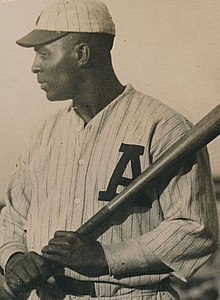
In baseball, batting average (AVG) is a measure of a batter's success rate in achieving a hit during an at bat, and is calculated by dividing a player's hits by his at bats. The achievement of a .400 batting average in a season was historically recognized as the coveted "standard of hitting excellence", in light of how batting .300 in a season is already regarded as very good. There have been 50 officially-recognized instances of a player have recorded a batting average of at least .400 in a single Major League Baseball (MLB) season, but none have done so since 1943, when Josh Gibson of the Homestead Grays hit .466, the single-season record. In the National League, the last to do so was Bill Terry of the New York Giants in 1930. Ted Williams of the Boston Red Sox is the last player to hit .400 in the American League. Four players – Ed Delahanty, Ty Cobb, Rogers Hornsby and Oscar Charleston – have accomplished the feat in three different seasons, Ross Barnes was the first player to bat .400 in a season, posting a .429 batting average in the National League's inaugural 1876 season.
In total, 36 players have reached the .400 mark in MLB history and seven have done so more than once. Of these, eighteen were left-handed batters, seventeen were right-handed, and one was a switch hitter, meaning they could bat from either side of the plate. Two of these players (Terry and Williams) played for only one major league team. The Philadelphia Phillies are the only franchise to have three players reach the milestone in the same season: Ed Delahanty, Billy Hamilton, Sam Thompson, all of whom Hall of Fame outfielders who attained a batting average over .400 during the 1894 season. The Homestead Grays are the only franchise with four players recording a .400 single-season batting average, albeit in different years: Joe Strong (1932), Josh Gibson (1937, 1943), Buck Leonard (1938) and David Whatley (1939) all hit .400 while playing for the Grays. Three players won the Most Valuable Player (MVP) Award in the same year as their .400 season: Ty Cobb (1911), George Sisler (1922) and Rogers Hornsby (1925). Rap Dixon, Tip O'Neill, Nap Lajoie, Josh Gibson (twice), Willie Wells, Mule Suttles, Oscar Charleston (twice), Heavy Johnson and Rogers Hornsby (twice) also earned the Triple Crown alongside achieving a .400 batting average, leading their respective leagues in batting average, home runs and runs batted in (RBI). Shoeless Joe Jackson of the Cleveland Naps hit .408 in 1911, the highest batting average ever recorded by a rookie in the American League. Joe Strong has the lowest career batting average among players who have batted .400 in a season with .266, while Gibson – with .372 – recorded the highest career average in major league history. (Full article...) -
Image 5

Bill Dawley was the starting pitcher for the Sounds' inaugural April 15, 1978, opener.
The Nashville Sounds Minor League Baseball team has played in Nashville, Tennessee, since being established in 1978 as an expansion team of the Double-A Southern League. They moved up to Triple-A in 1985 as members of the American Association before joining the Pacific Coast League in 1998. With the restructuring of the minor leagues in 2021, they were placed in the Triple-A East, which became the International League in 2022. The first game of the new baseball season for a team is played on Opening Day, and being named the Opening Day starting pitcher is an honor which is given to the player who is expected to lead the pitching staff that season, though there are various strategic reasons why a team's best pitcher might not start on Opening Day. The Sounds have used 43 different Opening Day starters in their 46 seasons.
Nashville's first Opening Day game was played against the Memphis Chicks at Tim McCarver Stadium in Memphis, Tennessee, on April 15, 1978. Bill Dawley was their starting pitcher that day; he took the decision in a game the Sounds lost, 4–2. Their first Opening Day game held at home was an 8–7 win against the Birmingham Barons at Herschel Greer Stadium on April 9, 1981. Starter Jamie Werly, who went on to win the Southern League Most Outstanding Pitcher Award that season, did not figure in the decision. On April 4, 2013, starter Tyler Thornburg took a no decision in the final Opening Day game at Greer Stadium, a 5–4 Sounds win. The team left Greer after the 2014 season, but did not play their first Opening Day game at First Horizon Park, their new facility then known as First Tennessee Park, until two years later. In that game, held on April 7, 2016, Sounds starting pitcher Chris Smith was charged with the loss in a 5–0 shutout by the Oklahoma City Dodgers. (Full article...) -
Image 6

In baseball, a home run is credited to a batter when he hits a fair ball and reaches home safely on the same play, without the benefit of an error. Sixty-two different players have hit two home runs in an inning of a Major League Baseball (MLB) game to date, the most recent being Brent Rooker of the Oakland Athletics on May 4, 2024. Regarded as a notable achievement, five players have accomplished the feat more than once in their career; no player has ever hit more than two home runs in an inning. Charley Jones was the first player to hit two home runs in one inning, doing so for the Boston Red Stockings against the Buffalo Bisons on June 10, 1880.
These innings have resulted in other single-inning and single-game MLB records being set due to the prodigious offensive performance. Bobby Lowe and Mike Cameron finished their respective games with a total of four home runs, equaling the record for most home runs in one game. Both of the home runs hit by Fernando Tatís in the third inning for the St. Louis Cardinals on April 23, 1999, were grand slams. Not only did he tie the record for most grand slams in one game, Tatís became the only player to hit two grand slams in the same inning and established a new major league record with eight runs batted in (RBI) in a single inning. A decade later, Alex Rodriguez set the single-inning American League record for RBIs with seven when he hit a three-run home run and a grand slam in the sixth inning for the New York Yankees on October 4, 2009. (Full article...) -
Image 7

Tony Mullane made five Opening Day starts for the Reds during the 1800s.
The Cincinnati Reds are a Major League Baseball franchise based in Cincinnati who play in the National League's Central Division. In their history, the franchise also played under the names Cincinnati Red Stockings and Cincinnati Redlegs. They played in the American Association from 1882 through 1889, and have played in the National League since 1890. The first game of the new baseball season for a team is played on Opening Day, and being named the Opening Day starter is an honor that is often given to the player who is expected to lead the pitching staff that season, though there are various strategic reasons why a team's best pitcher might not start on Opening Day. The Reds have used 76 Opening Day starting pitchers since they began play as a Major League team in 1882.
The Reds have played in several different home ball parks. They played two seasons in their first home ball park, Bank Street Grounds, and had one win and one loss in Opening Day games there. The team had a record of six wins and ten losses in Opening Day games at League Park, and a record of three wins and seven losses in Opening Day games at the Palace of the Fans. The Reds played in Crosley Field from 1912 through the middle of the 1970 season, and had a record of 27 wins and 31 losses in Opening Day games there. They had an Opening Day record of 19 wins, 11 losses and 1 tie from 1971 through 2002 at Riverfront Stadium, and they have a record of three wins and six losses in Opening Day games at their current home ball park, the Great American Ball Park. That gives the Reds an overall Opening Day record of 59 wins, 66 losses and one tie at home. They have a record of three wins and one loss in Opening Day games on the road. (Full article...) -
Image 8
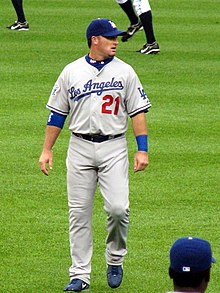
Mark Sweeney, the career pinch hit RBI recordholder, was named to the All-America Team in 1991 by both the American Baseball Coaches Association and Collegiate Baseball.
An All-American team is an honorary sports team composed of the best amateur players of a specific season for each position—who in turn are given the honorific "All-America" and typically referred to as "All-American athletes", or simply "All-Americans". Although the honorees generally do not compete as a unit, the term is used in U.S. team sports to refer to players who are selected by members of the national media. Walter Camp selected the first All-America team in the early days of American football in 1889. In 1950, the American Baseball Coaches Association (ABCA) selected its first All-American baseball team. It has since chosen All-American teams and a player of the year for each division (National Collegiate Athletic Association (NCAA) Division I, Division II, Division III, National Association of Intercollegiate Athletics, junior college and high school). In 1991, Collegiate Baseball began selecting college All-American, Freshman All-American, and High School All-American teams. Baseball America has selected – since 1981 – pre-season and post-season All-American teams and College Player of the Year honorees.
Various organizations selected All-American lists of the best players for the 1991 NCAA Division I college baseball season. The ABCA, the magazine Baseball America, and Collegiate Baseball were the NCAA-sanctioned selectors. This list only includes players selected to the post-season All-American first team for each selector. However, many All-American selections choose second, third, etc. teams from the remaining eligible candidates. (Full article...) -
Image 9

Clayton Kershaw holds the Dodgers' record for most Opening Day starts with nine (2011–2018 & 2021).
The Los Angeles Dodgers are a Major League Baseball (MLB) franchise based in Los Angeles. They play in the National League West division. The first game of the new baseball season for a team is played on Opening Day, and being named the Opening Day starter is an honor, which is often given to the player who is expected to lead the pitching staff that season, though there are various strategic reasons why a team's best pitcher might not start on Opening Day. The Dodgers have used 26 different Opening Day starting pitchers in their 67 seasons in Los Angeles. The 26 starters have a combined Opening Day record of 29 wins, 27 losses and 10 no decisions.
The Dodgers started playing in Los Angeles in 1958, after moving from Brooklyn. The first Opening Day game for the Dodgers in Los Angeles was played in San Francisco against the San Francisco Giants on April 15, 1958. California native Don Drysdale was the Dodgers' Opening Day starting pitcher that day, in a game the Dodgers lost 8–0. Dodgers starting pitchers won both of their Opening Day starts in their first home ballpark in Los Angeles, Los Angeles Memorial Coliseum. (Full article...) -
Image 10The Texas Rangers are an American baseball franchise based in Arlington, Texas. They are members of the American League West division. The Rangers franchise was formed in 1961, then called the Washington Senators, as a member of the American League. In its 62-year history, the Texas Rangers baseball franchise of Major League Baseball's American League has employed 28 managers. The duties of the team manager include team strategy and leadership on and off the field.
Mickey Vernon became the first manager of the then Washington Senators in 1961, serving for just over two seasons. Ron Washington has managed more games and seasons than any other manager in Rangers history. Before 2010, the only Rangers manager to have led the team to the playoffs was Johnny Oates, who also won the 1996 Manager of the Year Award with the Rangers. Ted Williams is the only Rangers manager to have been inducted into the Baseball Hall of Fame as a player; Whitey Herzog, who was inducted in the Hall in 2010, is only Rangers manager to earn induction as a manager. (Full article...) -
Image 11

Joe Quinn, the first Australian to play in MLB
The first recorded baseball event in Australia took place in Melbourne, Victoria in 1857, between teams from Collingwood and Richmond. Accounts vary as to the details, including whether it was a single game or a series of three games, though details in common include a score of 350–230 in favour of Collingwood, and that the rules used were some form of hybrid between cricket and baseball, with teams batting until all players were out, and runs being scored for every base crossed, rather than just for reaching home plate. Though there are no records to confirm it, the commonly held belief is that baseball in Australia originated on the Ballarat gold-fields among American miners. The Claxton Shield, the first annually recurring national tournament, commenced in 1934. Though the tournament itself has been supplanted at various points in its history, the physical Shield is still awarded to the national champions in the Australian Baseball League.
As of the 2024 Major League Baseball (MLB) season[update], 38 Australians have played in at least one MLB game. Of those players, 33 were born in Australia, the remainder having been born elsewhere but raised in Australia and have played for the Australia national baseball team at International Baseball Federation or sanctioned tournaments such as the Olympic Games and World Baseball Classic. 25 of the players have been pitchers and the other 13 have been position players. (Full article...) -
Image 12

Randy Johnson, the Opening Day starter from 1999 to 2004
The Arizona Diamondbacks are a Major League Baseball (MLB) franchise based in Phoenix, Arizona. They play in the National League West division. The first game of the new baseball season for a team is played on Opening Day, and being named the Opening Day starter is an honor, which is often given to the player who is expected to lead the pitching staff that season, though there are various strategic reasons why a team's best pitcher might not start on Opening Day. The Diamondbacks have used 10 different Opening Day starting pitchers in their 21 seasons. The 10 starters have a combined Opening Day record of eight wins, seven losses (8–7), and six no decisions. No decisions are only awarded to the starting pitcher if the game is won or lost after the starting pitcher has left the game.
Randy Johnson holds the Diamondbacks' record for most Opening Day starts with six, and has an Opening Day record of 3–2. Brandon Webb started four Opening Days, and Ian Kennedy has been the Opening Day starter thrice. Andy Benes, Javier Vázquez, Dan Haren, and Wade Miley have started one Opening Day each. Kennedy has the best winning percentage as the Opening Day starting pitcher with a record of 2–0. Benes, Vázquez, and Miley are tied for the worst Opening Day record, at 0–1. Webb is Arizona's only pitcher with multiple no-decisions on Opening Day (three), and Johnson is the only pitcher to have won three or more opening games. (Full article...) -
Image 13The San Francisco Giants are a Major League Baseball team that plays in the National League Western Division. Since their inception as the New York Gothams in 1883, the Giants have employed 37 managers. The duties of the team manager include team strategy and leadership on and off the field.
The franchise's first manager was John Clapp, who managed the team for one year before being replaced in 1884 by Jim Price. The New York Giants won two World Series championships during the 19th century, in 1888 and 1889, with Jim Mutrie as their manager both years.[a] John McGraw became the Giants' manager during the 1902 season, beginning a streak of 54 consecutive years in which the Giants were managed by a Baseball Hall of Famer. McGraw managed for the better course of 30 years (he missed parts of the 1924, 1925, and 1927 seasons due to illness; Hughie Jennings took over for the former two while Rogers Hornsby served as player-manager for the latter), doing so until the middle of the 1932 season, the longest managerial tenure in Giants history. McGraw won 2,583 games as the Giants manager, the most in Giants history. While managing the Giants, the team won the National League championship 10 times—in 1904, 1905, 1911, 1912, 1913, 1917, 1921, 1922, 1923 and 1924. They played in the World Series nine times (no World Series was played in 1904) and won three, in 1905, 1921 and 1922. (Full article...) -
Image 14

Mike Hampton has won five Silver Slugger Awards, best among all pitchers.
The Silver Slugger Award is awarded annually to the best offensive player at each position in both the American League (AL) and the National League (NL), as determined by the coaches and managers of Major League Baseball (MLB). These voters consider several offensive categories in selecting the winners, including batting average, slugging percentage, and on-base percentage, in addition to "coaches' and managers' general impressions of a player's overall offensive value". Managers and coaches are not permitted to vote for players on their own team. The Silver Slugger was first awarded in 1980 and is given by Hillerich & Bradsby, the manufacturer of Louisville Slugger bats. The award is a bat-shaped trophy, 3 feet (91 cm) tall, engraved with the names of each of the winners from the league and plated with sterling silver.
Only National League pitchers ever received a Silver Slugger Award; from the Silver Slugger Award's inception until 2019, and in 2021, a designated hitter generally took the place of the pitcher in the batting order in the American League. A Silver Slugger Award for designated hitters was given only in the American League during that time. (Full article...) -
Image 15

Ken Griffey Jr., the 1987 first overall draft pick
The first-year player draft, also known as the Rule 4 Draft, is the primary mechanism for assigning amateur baseball players from high schools, colleges, and other amateur baseball clubs to Major League Baseball (MLB) teams. Unlike most professional sports, MLB does not permit the trading of draft picks. Since 2023, the first six selections are determined by a lottery; the previous season's standings determine the remaining selections. If two teams have identical records, the team with the worse record in the previous season will receive the higher pick. In addition, teams that lost free agents in the previous off-season may be awarded "compensatory" picks. The first draft took place in 1965; it was introduced to prevent richer teams from negotiating wealthier contracts with top-level prospects and therefore, monopolizing the player market. Originally, three drafts were held each year. The first draft took place in June and involved high-school graduates and college seniors who had just finished their seasons. The second draft took place in January for high school and college players who had graduated in December. The third draft took place in August and was for players who participated in American amateur summer leagues. The August draft was eliminated after two years, and the January draft lasted until 1986.
In 1965, Rick Monday became MLB's first draft pick after being selected by the Kansas City Athletics. Travis Bazzana is the most recent first overall pick; he was drafted by the Cleveland Guardians in 2024. Overall, 23 of the 50 picks before 2015 have participated in the All-Star Game, and four (Bob Horner, Darryl Strawberry, Bryce Harper, and Carlos Correa) have won the Rookie of the Year Award. Twenty-five of the fifty picks before 2015 have been drafted from high schools, one has been drafted out of the Independent American Association, and the others were drafted from universities. To date, Arizona State University, Vanderbilt University, Louisiana State University, and Oregon State University are the only schools from which multiple number-one overall draft picks have been chosen. No first overall pick was inducted into the National Baseball Hall of Fame until 2016, when Ken Griffey Jr. was inducted with a record 99.3 percent of votes cast. Griffey has since been joined by three other top picks: Chipper Jones, inducted in 2018; Harold Baines, elected in December 2018 and inducted in July 2019, and Joe Mauer, inducted in 2024. (Full article...)
More did you know
- ... that Negro league baseball executive Cum Posey organized the East-West League in 1932, but the league folded before the end of the season?
- ... that Freeman Fitzgerald played football with Knute Rockne and once struck out 19 batters in a baseball game?
- ... that despite being named one of the "top prospects of the decade" by Baseball America, American baseball pitcher Nick Neugebauer compiled a career record of just two wins and eight losses?
- ... that Milwaukee Brewers baseball player Dan Thomas was called the "Sundown Kid" because he refused to play on Sabbath?
- ... that when Roger Bresnahan adopted the use of shin guards in Major League Baseball on Opening Day in 1907, angry fans threw snow onto the field?
Sports portals
Selected picture

| Credit: National Photo Company |
Tyrus Raymond "Ty" Cobb (December 18, 1886 – July 17, 1961), nicknamed "The Georgia Peach," was a baseball player and is regarded by some historians and journalists as the best player of the dead-ball era and is generally seen as one of the greatest players of all time. Cobb also received the most votes of any player on the 1936 inaugural Hall of Fame Ballot, receiving 222 out of a possible 226 votes. Cobb is widely credited with setting ninety Major League Baseball records during his career.
Associated Wikimedia
The following Wikimedia Foundation sister projects provide more on this subject:
-
Commons
Free media repository -
Wikibooks
Free textbooks and manuals -
Wikidata
Free knowledge base -
Wikinews
Free-content news -
Wikiquote
Collection of quotations -
Wikisource
Free-content library -
Wikiversity
Free learning tools -
Wiktionary
Dictionary and thesaurus
More portals
- Portals with triaged subpages from June 2018
- All portals with triaged subpages
- Portals with no named maintainer
- Automated article-slideshow portals with 51–100 articles in article list
- Automated article-slideshow portals with 501–1000 articles in article list
- Random portal component with 41–50 available subpages
- Automated article-slideshow portals with 201–500 articles in article list
- Random portal component with 11–15 available subpages
- Random portal component with 21–25 available image subpages




